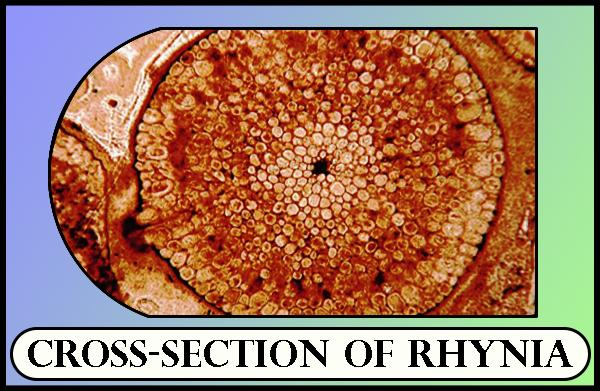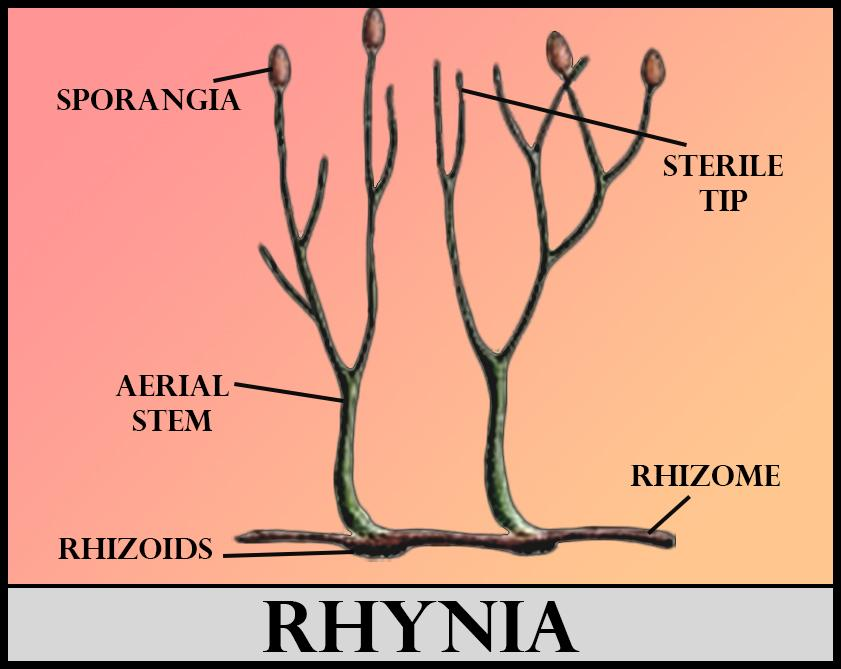
Which of the following is a fossil pteridophyte?
(a) Lycopodium
(b) Lygodium
(c) Psilotum
(d) Rhynia
Answer
552.9k+ views
Hint: Fossils of this leafless and rootless vascular plant have been obtained from rock strata that date back to the Silurian and Devonian periods of the Palaeozoic era.
Complete answer:
Rhynia is a single-species genus of the Silurian and Devonian vascular plants that belong to the fossil pteridophyte. Rhynia Gwynne-vaughanii was the sporophyte generation of an axial, free-sporing diplohaplontic embryophyte land plant of the Lower Devonian era. It has been found that these plants had more advanced anatomical features than those of the bryophytes present in that particular era.
Additional Information: -Rhynia was first described by Robert Kidston and William H. Lang in 1917 as a new species.
-In the Transverse Section of rhynia the stele is haplostele. The xylem is made up of annular tracheids and the sieve plates are absent in the phloem.
-Lycopodium or ground pines are flowerless terrestrial plants having widely branched, erect, or creeping stems, that have needle-like leaves that cover the stem and branches thickly.
-Lygodium, also called climbing fern, is the sole genus in the family Lygodiaceae.
-Commonly known as whisk ferns, Psilotum is a genus of fern-like vascular plants. They also lack true roots and leaves and their stems act as conducting tissue.
So, the correct answer is ‘Rhynia’
Note: -Pteridophytes have a long geological history on our planet. The fossil evidence dates as far back as 380 million years ago.
-Embryophytes are complex multicellular eukaryotes having specialized reproductive organs. They nurture their young embryo sporophyte during the early stages of its multicellular development within the tissues of the parent gametophyte.
-The word Diplohaplontic describes a life cycle that has alternating haploid and diploid phases.


Complete answer:
Rhynia is a single-species genus of the Silurian and Devonian vascular plants that belong to the fossil pteridophyte. Rhynia Gwynne-vaughanii was the sporophyte generation of an axial, free-sporing diplohaplontic embryophyte land plant of the Lower Devonian era. It has been found that these plants had more advanced anatomical features than those of the bryophytes present in that particular era.
Additional Information: -Rhynia was first described by Robert Kidston and William H. Lang in 1917 as a new species.
-In the Transverse Section of rhynia the stele is haplostele. The xylem is made up of annular tracheids and the sieve plates are absent in the phloem.
-Lycopodium or ground pines are flowerless terrestrial plants having widely branched, erect, or creeping stems, that have needle-like leaves that cover the stem and branches thickly.
-Lygodium, also called climbing fern, is the sole genus in the family Lygodiaceae.
-Commonly known as whisk ferns, Psilotum is a genus of fern-like vascular plants. They also lack true roots and leaves and their stems act as conducting tissue.
So, the correct answer is ‘Rhynia’
Note: -Pteridophytes have a long geological history on our planet. The fossil evidence dates as far back as 380 million years ago.
-Embryophytes are complex multicellular eukaryotes having specialized reproductive organs. They nurture their young embryo sporophyte during the early stages of its multicellular development within the tissues of the parent gametophyte.
-The word Diplohaplontic describes a life cycle that has alternating haploid and diploid phases.


Recently Updated Pages
Why are manures considered better than fertilizers class 11 biology CBSE

Find the coordinates of the midpoint of the line segment class 11 maths CBSE

Distinguish between static friction limiting friction class 11 physics CBSE

The Chairman of the constituent Assembly was A Jawaharlal class 11 social science CBSE

The first National Commission on Labour NCL submitted class 11 social science CBSE

Number of all subshell of n + l 7 is A 4 B 5 C 6 D class 11 chemistry CBSE

Trending doubts
10 examples of friction in our daily life

One Metric ton is equal to kg A 10000 B 1000 C 100 class 11 physics CBSE

Difference Between Prokaryotic Cells and Eukaryotic Cells

1 Quintal is equal to a 110 kg b 10 kg c 100kg d 1000 class 11 physics CBSE

State the laws of reflection of light

Explain zero factorial class 11 maths CBSE




